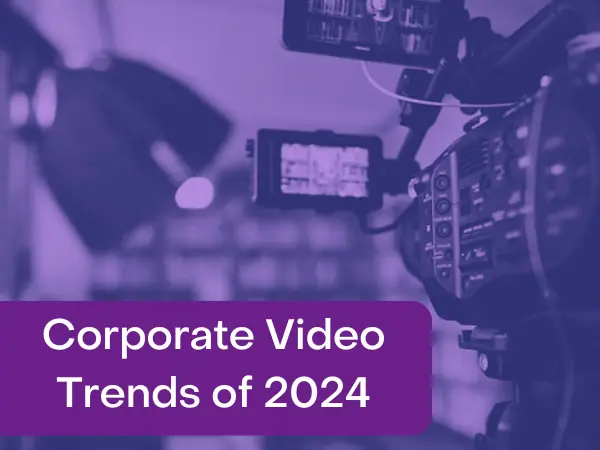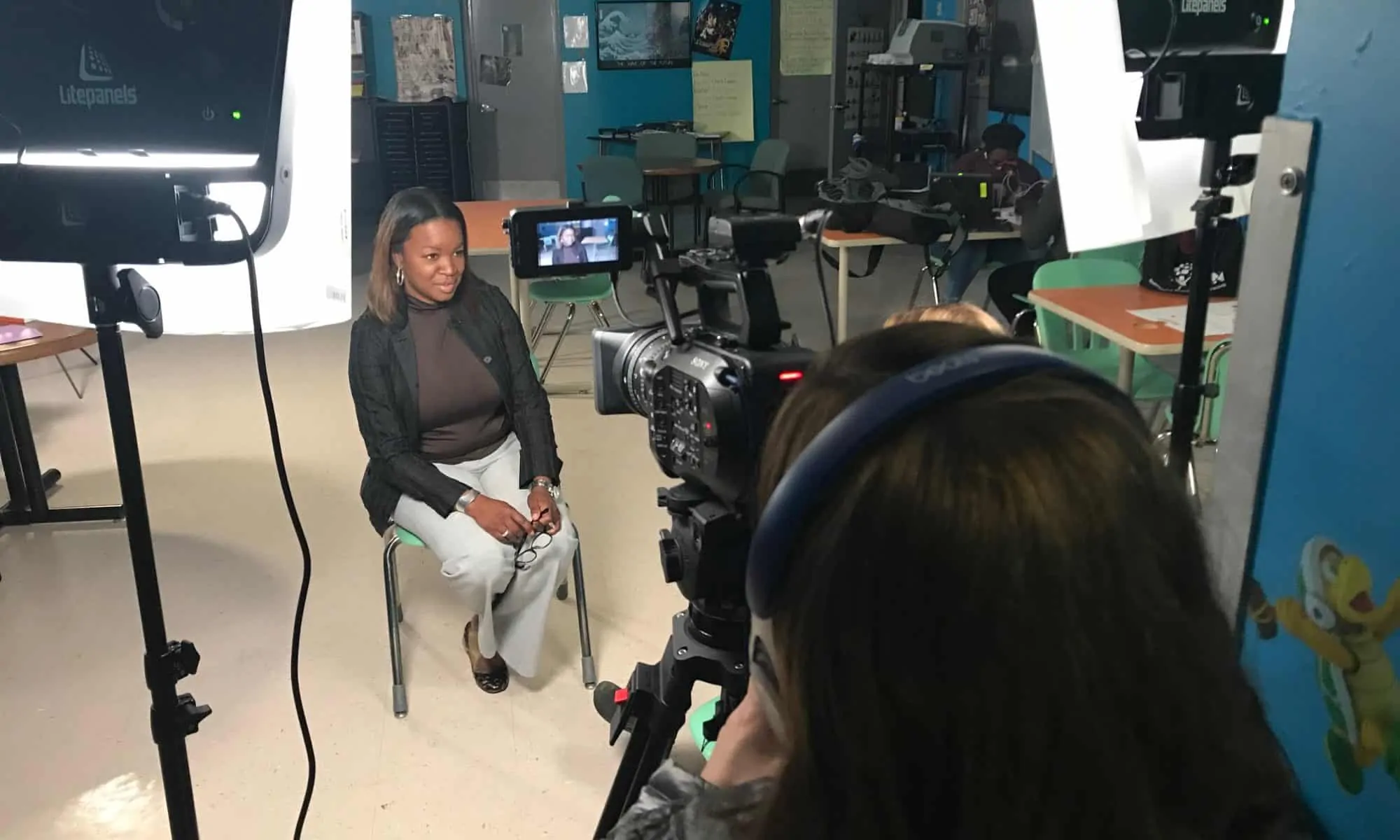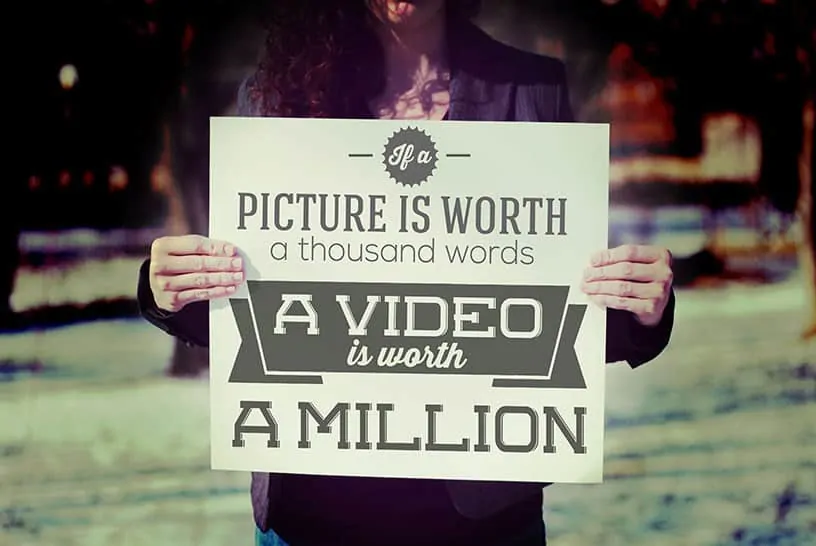Corporate Video Trends of 2024
While it’s always difficult to know exactly where the year will take us (nod back to 2020, whereby everyone shut down in March), it is possible to look forward and make an educated guess as to where the corporate video trends will go in 2024. Let’s get into where we think the trends are heading.
Emerging Technologies and Their Impact on Corporate Video Trends
Everyone says AI is taking over the world. Yes, it is. But can it fully take over video production right now? No, we don’t believe it can. Where AI can assist corporate video is how companies will create their ideas. It may even help create ideas that we humans haven’t thought of yet.
AI-Driven Video Creation: Artificial intelligence is a corporate video trend we all knew would be mentioned in 2024. AI is streamlining video production by automating tasks such as editing, color correction, and scriptwriting but it still takes a human to determine if what was corrected is, in fact, actually correct. More likely, AI will help analyze viewer data to enable the creation of content that better matches audience preferences, leading to more personalized and engaging videos. We see this already on YouTube’s “Recommended” Feature in the YouTube Studio.
Virtual Production: This technology brings the capabilities of high-end film production to corporate video, allowing for the creation of realistic environments without physical sets. Virtual production reduces logistical costs and enhances creative possibilities, enabling products or brands to be showcased in any setting imaginable, all while maintaining high production values.
By leveraging AI and virtual production, businesses can produce standout content more efficiently and engage their audiences in more meaningful ways. These technologies are not just improving how videos are made; they’re redefining the possibilities for corporate communication, promising more personalized, immersive, and interactive content. In 2024, the use of AI-driven video creation and virtual production is expected to grow, setting new benchmarks for corporate video excellence.
Authenticity and Storytelling in Corporate Videos
One of the more recent corporate video trends is the notion that audiences prefer authenticity and connection. Corporate videos that leverage genuine narratives and storytelling not only stand out but also create a lasting impact on their viewers. This trend towards authenticity and storytelling is shaping how companies approach video content in 2024.
Authenticity Breeds Trust: Authenticity serves as a method of garnering trust. Companies are moving away from pushy sales-centric videos in favor of content that showcases real people, real stories, and genuine experiences. This approach helps humanize brands, making them more relatable and trustworthy to their audience.
Storytelling Connects on a Deeper Level: Storytelling is a powerful tool. It goes beyond mere product features or benefits, weaving a narrative that engages viewers emotionally. Whether it’s through customer success stories, behind-the-scenes looks at the company culture, or stories that highlight the impact of a product or service, storytelling videos draw viewers in and leave a more profound, memorable impression. The key is a strong balance between too much story and making your point quickly enough not to lose the viewer.
Incorporating User-Generated Content: One way companies are enhancing authenticity in their videos is by incorporating user-generated content. This type of content, created by customers or employees, adds a layer of authenticity that can’t be replicated with traditional production methods. It also fosters a sense of community and engagement around the brand.
Challenges and Opportunities: While the push towards authenticity and storytelling offers a path to deeper audience connection, it also presents challenges. Crafting compelling narratives requires a keen understanding of the brand’s identity and audience’s values. However, when executed well, storytelling can transcend traditional marketing, turning corporate videos into impactful narratives that resonate with viewers on a personal level.
As we look at corporate video trends of 2024, the importance of authenticity and storytelling in corporate videos is only expected to grow. Businesses that can master this art will not only captivate their audiences but also build stronger, more meaningful connections with them.
Innovative Content Formats for Corporate Communication
Another of the more interesting corporate video trends is the number of content formats available to businesses has grown dramatically in recent years. In 2024, companies are not just producing traditional videos; they are exploring new, innovative formats to engage their audience. These include interactive videos, live broadcasts, and even immersive 360-degree experiences.
Interactive Videos: Interactive videos have risen in popularity, offering viewers a participatory experience. These videos allow audiences to make choices that affect the video’s storyline or outcome, turning passive viewers into active participants. For corporate communication, this means creating training modules, product demos, or even interactive annual reports where stakeholders can choose what information they want to explore.
Live Broadcasts: Live broadcasts have become a staple in the corporate communication toolkit. They offer real-time engagement with audiences, be it through Q&A sessions, product launches, or behind-the-scenes glimpses. The authenticity and immediacy of live video foster a sense of community and transparency between businesses and their audience.
Immersive 360-Degree Experiences: While not universally adopted, 360-degree videos offer an immersive viewing experience, placing the audience in the center of the action. For businesses, this could mean virtual tours of facilities, immersive product experiences, or even 360-degree coverage of events. These videos provide a unique perspective, offering viewers a more comprehensive understanding of the subject matter.
The adoption of these innovative content formats signifies a shift in corporate video communication. By embracing these formats, businesses can engage their audiences in more meaningful, interactive, and immersive ways. The key to success lies in understanding which formats best align with the company’s communication goals and audience preferences.
As we navigate through the corporate video trends of 2024, the exploration of new content formats in corporate video is expected to continue, pushing the boundaries of how businesses communicate with their stakeholders.
Strategic Video Placement Across Digital Platforms
In 2024, creating compelling corporate videos is only part of the equation; strategically placing these videos across various digital platforms is critical for maximizing reach and engagement. Businesses are diversifying their video distribution strategies to include not just traditional channels like company websites and YouTube but also social media, email campaigns, and streaming services.
Social Media Platforms: Each social media platform offers unique advantages for video content. YouTube is one of the largest video platforms in the online world. Instagram, for example, is ideal for short, engaging clips, while LinkedIn is perfect for B2B videos that showcase industry expertise or company culture. Tailoring video content to the strengths of each platform can dramatically increase its effectiveness.
Corporate Websites and Blogs: Videos embedded on company websites or blogs can significantly enhance user experience and SEO. Explainer videos, testimonials, and product demos on relevant pages or posts can help convert visitors into customers by providing valuable information in an engaging format.
Here’s an example (above).
Email Campaigns: Including videos in email campaigns can boost open rates and engagement. A compelling video thumbnail in an email invites recipients to click through to watch the full video, whether it’s a product announcement, a behind-the-scenes look, or a message from the CEO.
Advertisements on Streaming Services: With the rise of streaming platforms, placing advertisements or sponsored content in this space can reach audiences who are increasingly shifting away from traditional TV. Targeted ads on platforms like Hulu or Netflix can capture the attention of viewers in a less saturated advertising environment.
Strategic placement ensures that videos reach their intended audience in the most effective manner. By understanding the unique benefits of each platform and aligning them with the video’s goals and target audience, businesses can leverage their video content to achieve maximum impact.
As we continue through 2024, the strategic placement of corporate videos will become even more sophisticated, with companies leveraging data analytics and AI to fine-tune their distribution strategies for optimal engagement and ROI.
Measuring Success: Analytics and ROI of Corporate Videos
In 2024, one of the most important corporate video trends is the emphasis on quantifying the impact a placed video. Businesses are increasingly leveraging sophisticated analytics tools to measure the success and return on investment (ROI) of their video content. This shift towards data-driven strategies enables companies to make informed decisions about their video marketing efforts, optimizing for better engagement, conversion rates, and overall performance.
Key Performance Indicators (KPIs): Identifying the right KPIs is crucial for measuring video success. These may include view count, engagement rate (likes, shares, comments), watch time, conversion rate, and click-through rate (CTR). By analyzing these metrics, businesses can gauge how well their content resonates with their audience and contributes to their marketing goals.
Analytics Tools: Advanced analytics platforms provide deep insights into video performance across various channels. Tools like Google Analytics, social media insights, and video hosting analytics (e.g., YouTube, Vimeo) offer a comprehensive view of how videos are performing in terms of viewer engagement and behavior. This data is invaluable for refining content strategy and improving video effectiveness.
ROI Measurement: Calculating the ROI of corporate videos involves assessing both direct and indirect benefits. Direct benefits might include increased sales or leads directly attributed to video campaigns. Indirect benefits could encompass enhanced brand awareness, customer loyalty, and long-term customer value. A combination of quantitative data and qualitative insights can help paint a complete picture of video ROI.
Continuous Optimization: The journey doesn’t end with measuring initial performance. Successful businesses use these analytics to continuously optimize their video content and distribution strategies. A/B testing different video formats, calls-to-action (CTAs), and distribution channels can help identify what works best for reaching and engaging the target audience.
In 2024, the ability to measure and understand the impact of corporate video is a competitive advantage. Companies that master the art of video analytics are well-positioned to tailor their content strategies effectively, ensuring that every video they produce delivers maximum value. Ask us how.
Related Information:
Video Marketing Trends of 2024
Filma-Corporate Video Trends 2024
How To Use Video and Video Marketing For Your Business
Keywords: Corporate Video Trends 2024, Business Communication, AI Video Creation, Video Storytelling, Digital Video Strategy





















